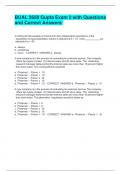03/10/2019
Lifespan is overtaking health-span; so, we can treat and avoid diseases because of better
medical care, but our lifestyle is causing obesity, mental health disorders, substance abuse
etc.
Diseases (i.e. dementia, Alzheimer’s) are being discovered at a faster rate, but some others
are being eradicated (i.e. smallpox).
Health: allows a person to live a socially and economically productive life
Aetiology: Cause of the disease
Pathogenesis: Sequence of events from aetiology and expression
Morphology: form of cells and tissues
Histology: Study of cells and tissues
Symptom: Subjective complaint of sufferer
Diagnosis: cause of particular health complaint (symptoms, background, tests, physical
examination)
Epidemiology: study of disease distribution and determinants in specific human populations.
Explains spread of diseases during epidemics.
Framingham study (1950’s): study of cigarette smoke and increasing risks for heart disease,
cholesterol, hypertension etc.
Tasks in epidemiology: Public health surveillance (mortality, morbidity), field investigation
(track infected people, contacts with diseased patients, gain hypothesis), Analytic studies
(analysing the studies and investigation), Evaluation (effectiveness of programme, efficiency
of a programme for the intended results), Linkages and policy
Past generations affect your health and lifestyle now i.e. if they smoked, you’re likely to be
influenced by this, obese parents have obese kids, if your grandmother lived near a city road
the pollution could affect you now.
10/10/2019
Regulated cell death – enzymes & proteins must be involved (apoptosis, autophagy,
necroptosis). (Necrosis is accidental)
Gangrene – problems or damages to blood vessels to prevent blood circulation, leading to
blackening and death of extremity tissues.
Hypoxia – if tissues lack oxygenated blood (from poor circulation or damages), ATP and
energy metabolism cannot take place in those cells. The extremities must be amputated, or
dead tissue must be removed to avoid septicaemia.
^^^^^ these are both forms of necrotic cell death
Regulated cell death example is the metamorphosis of certain animals, certain cells must die
in the growing process to create the right form.
Necrosis – Cells don’t seem to be stacked evenly (gaps resembling white areas), cell lysis
material, nuclei are not visible, or the structure is changed (almost like condensation), cell
debris (usually in the form of tiny circles), leakage occurs and cell bursts (membrane is
broken), myelin figures (?). CASPASE INDEPENDENT.
Necrosis causes – Hypoxia, Pathogens, Harsh conditions (i.e. frostbite), Cell injury.
, Necrosis triggers cytotoxins to spill out, which is what causes inflammation.
Apoptosis triggers – cell development during birth etc., disease (body killing cancer cells),
TNF (tumour necrosis factor), cytotoxic drugs.
Apoptosis – enzymes digest cytotoxic components to avoid leakage, plus nuclear fragments.
Membrane-bound apoptotic bodies (budding) pinch off from the cell until it’s all broken up,
healthy cells phagocytose apoptotic bodies, shrinking of the budding cell. CASPASE
DEPENDENT.
Sometimes cell recovery can occur in necrosis e.g. if someone is getting frostbite but then
they’re brought into a warm place.
Caspases – (cystine-aspartic proteases), break down peptide bonds (i.e. trypsin), expressed
as zymogens (inactive precursor proteins) called procaspases > activated by cleavage of
specific peptide bond (specific peptide bonds must be cleaved and broke in order to activate
it), this makes the N terminus active, therefor activating the rest of the cell.
Initiator caspases (i.e. 8, 9) – activate other caspases (caspase cascade)
Executioner caspases (i.e. 3, 7) – directly involved in cell death
Apoptotic pathways – Intrinsic (changes INTERNALLY , extrinsic (changes EXTERNALLY)
Intrinsic (inside the cell) – Pro-apoptotic factors sent to mitochondria, so it can leak its
cytochrome c to form apoptosome and activating caspase 9 (initiator caspase), they then
activate executioner caspases (3 or 7). Cytochrome C gets released into cytosol through
mitochondrial permeability transition pore (MPTP).
Extrinsic (outside the cell) – lethal ligands (i.e. TNF, FasL) binds to death receptor FasR on cell
membrane, a DISC (death inducing signalling complex) complex is formed and caspase 8 is
activated, which activated executioner caspase 3.
The pathways are linked through the cleavage of BH3 only protein BID , BH3 is a domain
within BID (domains can regulate the function in many of these proteins).
Pro apoptotic factors are: tBID , Bax, Bak, Bim, Bad, High mitochondrial (Ca2+) – open the
mitochondrial permeability transition pore (MPTP).
Anti-apoptotic factors are: Bcl-2 and Bcl-xL – close the mitochondrial permeability transition
pore (MPTP).
Cancer cells tend to over express anti-apoptotic factors, making the cell unable to undergo
apoptosis. Clinical trials are active in stopping the expression of these in cancer cells.
When cytochrome C is released into cytosol, it increases cytosolic Ca2+ levels (high calcium),
leading to different things (look at PowerPoint sorry). Caused by Heat/pH, Toxins, Trauma,
Hypoxia etc.
Long-term calcium increase can activate cytoskeletal proteins breakdown, lipases,
endonucleases (they breakdown DNA), calpains, impaired mitochondria.
Necroptosis – Regulated necrosis (RN) – Receptor interacting protein kinase (inhibited by
necrostatin-1) like RIPK1 and RIPK3 (hehehe rest in peace kinases) activate mixed lineage
kinase domain-like (MLKL), then MLKL activates transient receptor potential Ca2+ channel
(TRPs) (so calcium is still involved), and then the calcium increase leads to plasma membrane
permeability.
MPT-driven RN – p53 triggers mitochondrial permeability by activating mitochondrial
permeability transition pore (MPTP), meaning ROS (reactive oxidant species) causes plasma
membrane permeability (elephants don’t get cancer because they have 40 copies of the p53
gene, so the cell can always go through cell death even if the anti-apoptotic enzymes are
further activated.
Autophagy – cell eats itself to avoid damaged proteins and organelles. Signals (i.e.
starvation) induce formation of double-membrane structures (phagophores), which take










